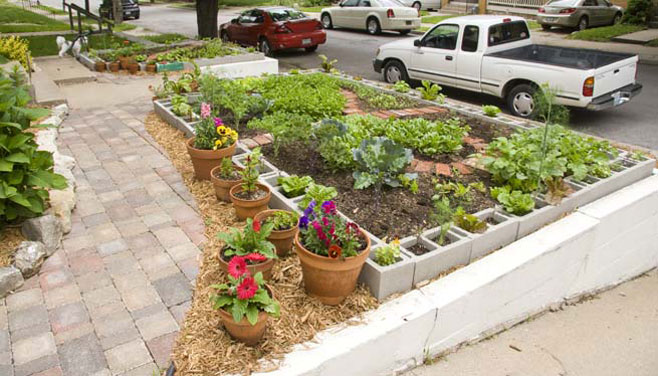Eat Your Yard: Urban Food Gardens
Healthy green Dinosaur Kale and Bright Lights Swiss Chard mix with peonies and irises, alongside deep red rhubarb and bushes bursting with fresh blueberries, in the heart of the city; while carrots and potatoes send leafy shoots toward the sun.
Urban gardens are increasingly taking on a different appearance. Vegetable gardens are popping up more frequently and even migrating to the front yard. More people who are concerned about the quality and source of their food are digging in the dirt, reviving old-fashioned pest-control methods, and reaping the satisfaction of plucking dinner ingredients from their yards.
Welcome to the Food Not Lawns movement. People are realizing that, if they want healthy food, they have to be responsible for it themselves. It typically takes about 10 calories of fossil fuel to produce one calorie of food in the grocery store, which is often shipped 1,000-1,500 miles to local stores.
LAWN LIABILITIES
Steve Mann, with Food Not Lawns Kansas City (part of Food Not Lawns International), says that traditional lawns are a huge resource problem, which must be addressed. “It’s a forest wanting to come into existence from the original ecosystem. We use fossil fuels, herbicides and pesticides on lawns because they’re not a stable system. Lawns are huge users of water, especially during the hot summer, and the chemicals are going into the water system and eventually into the Gulf of Mexico.”
The organization wants to change unproductive lawns into productive gardens and be a resource for information on how to practice this work. “I’m seeing more and more people who don’t want lawns, especially among people in their 20s,” Mann says. “About half have knowledge about what it takes to have a successful garden. Education mostly takes place in our Communiversity classes, usually two times a year and we’ve had hundreds of people come through.”
OUR CHANGING BEHAVIOR
Interest in urban gardening is clearly on the rise. “I hear ‘organic’ over and over again and I think people are really trying to eat more organic fruit and vegetables,” says Erin Busenhart, a designer at Overland Park’s Family Tree Nursery. “You can decide exactly what you’re going to grow, what fertilizer you will use, and pick it exactly when it’s ready. The more success you have, you can start increasing your beds.
“People are becoming more aware of fresh produce, and they want to try more varieties. The lines are beginning to blur between a flower garden and a vegetable garden and we’re mixing herbs into our flower beds.”
Increasingly, fruit-bearing trees are more compact or have several varieties growing simultaneously, so urban gardeners don’t have to have an orchard to grow their own apples. And some artichoke varieties are ready in only 85 days.
URBAN FOOD GARDENS TAKE HOLD
Roeland Park resident, Duane Daugherty, learned to garden from his grandmother, who had a small farm in Lowry, MO and a home in Liberty. “We would spend hours in the garden and she never used any chemicals,” he says. “She kept slugs and bugs away by putting a cup of beer in the garden.”
Daugherty’s family moved to their current house in 1993. He was traveling constantly for about 10 years but wanted to cook on weekends, so he created a small backyard garden plot. Eight years ago, the 4 x 10 garden featured tomatoes and peppers as well as snow peas, butter lettuce, spinach, kale and chard. Today Daugherty’s garden plots cover approximately 575 square feet and 15-20 percent of the backyard.
He has expanded in areas where grass wouldn’t grow and started putting in raised beds with a soil blend that incorporates good topsoil with compost and peat moss. Daugherty won’t use treated wood around vegetables and herbs, favoring pine rubbed with linseed oil (pricier cedar or redwood also works very well). He uses white vinegar as weed killer although it won’t cling to a plant in the rain. At the height of growing season Daugherty spends 15-20 minutes a day watering and weeding and 1-2 hours, average, on Saturdays.
He uses plenty of hybrid plants but no GMOs because hybrids can be more tolerant of our extreme weather and have a better yield and longer growing season. As summer approached, Daugherty was also considering planting a mix of pretty and edible flowers and herbs along the north side of the house. “They smell so good, as you get out of your car,” he says.
A FAMILY AFFAIR
Daugherty’s now-grown daughters both helped in the garden through their years at home, and still help out occasionally, while his wife puts primary focus on flowering plants.
“I’m seeing more and more younger families that have actually never planted anything before in their lives,” Busenhart says. “They’re ready to rip out some sod and really start planting, including fruit trees such as raspberries and blackberries, and heirloom tomatoes. I think the kids are super-excited. Plant jelly bean tomatoes, and carrots and they get to check the plants every day and they actually want to try the vegetables.”
NOT JUST FOR BACKYARDS
While interest in backyard food gardens has definitely grown, incorporating edibles into front gardens is less common. Hermes Landscaping recently installed an edible landscape in front of their Lenexa headquarters, after the city disrupted existing landscape when burying an open creek bed.
“Our vision is to become part of the edible landscape community and offer some professional advice when creating landscapes like it,” says Sarah Hermes, manager of marketing and innovation. “Interacting with your landscape in a more tangible way, I think, is profound for human health and wellness, both emotionally and physically; and on the environment and our food system.”
Ami Freeberg, Community Outreach Coordinator for Cultivate Kansas City, is also bucking convention. Raised in Fairfield IA, with two big gardens, she watched her Mom plant food amid flowers, all along. Now Freeberg is transforming her Volker neighborhood front yard into an edible landscape. Up to 95% of her yard features edible and floral gardens. Freeberg uses organic fertilizer and compost and tries to chase pests away.
“The front yard is new this spring so I’ve been out working a lot and I was digging up all the grass and I got some looks like, ‘What’s going on here?’” Freeberg says. “I put in cinder blocks and brought in some compost and did sort of a raised bed [design]. I’ve gotten a lot of ‘That’s really neat,’ and one neighbor who has said, ‘This is so inspiring.’ People are intrigued.”
Greens, spinach, arugula, herbs, and carrots fill Freeberg’s front yard, while tomatoes, peppers, and perennial herbs grow in back. Kale is by far the thing that she has planted the most of.
“At work, I spend a lot of time in front of the computer, so I like to work in the dirt,” Freeberg says. “It’s mostly about the joy of gardening and the sense of accomplishment. I did all the work to grow and harvest and eat that. [A food garden is] the most intimate connection you can have with your food, because you get to see the whole process. Even if you’re only doing a few things, you gain an appreciation for what goes into the food you’re creating.”





